Abstract
We use a financial market model that is able to replicate stylized facts of financial markets quite successfully. We adjust this model by integrating regulations of Basel II concerning market risk. The result is a considerable destabilization of the regulated financial market with a significant increase of extreme events (extraordinary profits and losses). Since the intention of Basel II regulations is to ensure banks have enough regulatory capital to withstand periods involving extraordinary losses, it is alarming that – on the contrary – these regulations may provoke an increase in precisely such extraordinary events.
Similar content being viewed by others
References
C. Hommes, in Handbook of Computational Economics, Agent-Based Computational Economics, edited by L. Tesfatsion, K.L. Judd (North Holland/Elsevier, Amsterdam, 2006), Vol. 2, pp. 1109–1185
B. LeBaron, in Handbook of Computational Economics, Agent-Based Computational Economics, edited by L. Tesfatsion, K.L. Judd (North Holland/Elsevier, Amsterdam, 2006), Vol. 2, pp. 1187–1232
A. Kirman, in Money and financial markets Blackwell, edited by M. Taylor (Blackwell, Oxford, 1991), pp. 354–368
S. Bornholdt, Int. J. Mod. Phys. C 12, 5 (2001)
W.A. Brock, C. Hommes, J. Econ. Dyn. Cont. 22, 8 (1998)
S.-H. Chen, C.-H. Yeh, J. Econ. Beh. Org. 49, 2 (2002)
D. Farmer D, S. Joshi, J. Econ. Beh. Org. 49, 2 (2002)
P. de Grauwe, M. Grimaldi, Eur. Econ. Rev. 50, 1 (2006)
B. LeBaron, B. Arthur, R. Palmer, J. Econ. Dyn. Cont. 23, 9 (1999)
M. Raberto, S. Cinotti, S.M. Focardi, M. Marchesi, Comput. Econ. 22, 2 (2003)
K. Mannaro, M. Marchesi, A. Setzu, J. Econ. Beh. Org. 67, 2 (2008)
F. Westerhoff, R. Dieci, J. Econ. Dyn. Cont. 30, 2 (2006)
X.-Z. He, F. Westerhoff, J. Econ. Dyn. Cont. 29, 9 (2005)
F. Westerhoff, J. Int. Fin. Markets. Inst. Money 13, 5 (2003)
M. Crouhy, D. Galai, R. Mark, The Essentials of Risk Management (McGraw-Hill, New York, 2006)
BCBS, International Convergence of Capital Measurement and Capital Standards (Bank for International Settlements, June 2006)
J. Kerkhof, B. Melenberg, J. Banking Fin. 28, 8 (2004)
H. Benink, J. Daníelsson, Á. Jónsson, Fin. Markets Institutions Instruments 17, 1 (2008)
T. Lux, M. Marchesi, Nature 397, 6719 (1999)
T. Lux, M. Marchesi, Int. J. Theor. Appl. Fin. 3, 4 (2000)
W. Weidlich, G. Haag, Concepts and Models of a Quantitative Sociology — The Dynamics of Interacting Populations (Springer, Berlin, 1983)
S. Alfarano, T. Lux, F. Wagner, Comput. Econ. 26, 1 (2005)
S. Alfarano, T. Lux, Macroecon. Dyn. 11, S1 (2007)
C. Marrison, The Fundamentals of Risk Management (McGraw-Hill, New York, 2002)
A. McNeil, R. Frey, P. Embrechts, Quantitative Risk Management: Concepts, Techniques, and Tools (Princeton University Press, Princeton, 2005)
R.-D. Reiss, M. Thomas, Statistical Analysis of Extreme Values with Applications to Insurance, Finance, Hydrology and Other Fields, 3rd edn. (Birkhäuser, Boston, 2007)
G. Stahl, Risk 10, 5 (1997)
J. Daníelsson, P. Hartmann, C. de Vries, Risk 11, 1 (1998)
F. Westerhoff, J. Econ. Stat. 228, 2 (2008)
T. Lux, M. Ausloos, in The Science of Disasters: Climate Disruptions, Heart Attacks, and Market Crashes, edited by A. Bunde, J. Kropp, H.J. Schellnhuber (Springer, Berlin, 2002), pp. 373–409
C. Homburg, P. Scherpereel, Controlling Management 49, 4 (2005)
G.A. Holton, Value-at-Risk: Theory and Practice (Academic Press, Elsevier, Amsterdam, 2003)
P. Zangari, RiskMetrics — Technical Document, 4th edn. (Morgan Guarantee Trust Company, Reuters Ltd., New York, 1996)
Author information
Authors and Affiliations
Corresponding author
Rights and permissions
About this article
Cite this article
Hermsen, O. Does Basel II destabilize financial markets? An agent-based financial market perspective. Eur. Phys. J. B 73, 29–40 (2010). https://doi.org/10.1140/epjb/e2009-00382-1
Received:
Revised:
Published:
Issue Date:
DOI: https://doi.org/10.1140/epjb/e2009-00382-1




